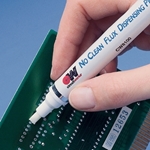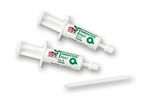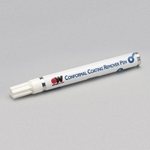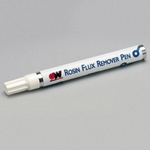Essential Guide to Flux for Soldering Electronics
When joining two metals in a soldering process, like used in PCB assembly, flux is required to achieve a true metallurgic bond. That ensures the solder joint doesn’t crack or come loose even with the day-to-day wear-and-tear. This article covers the types of fluxes available, the advantages and disadvantages of each, and options for flux removal.
What is Flux?
Flux aids in soldering and desoldering processes by removing oxide films which form on the surface of metals being soldered. It increases the wetting ability of the solder, causing it to flow more uniformly over surfaces without balling-up (dewetting).
Rosin (type R) Flux
The most basic soldering flux, one that has been used for over a thousand years, is the natural rosin derived from pine tar resin. Pine tar resin is dissolved in solvent and then distilled to yield the clear, water-white rosin used in soldering flux. Rosin is a collection of naturally occurring acids, chiefly abietic acid and its homologs. When used as a soldering flux, the clear rosin is dissolved in a solvent, usually isopropyl alcohol. When used in this manner, without the addition of acid activators, it is referred to as type R rosin flux.
Activators are added to soldering flux to increase the ability of the flux to dissolve heavier oxide films, especially those produced at the higher soldering temperatures required for lead-free solder alloys. Activated fluxes can be either mildly activated or type RMA (rosin - mildly activated) or RA (rosin -activated). Activators commonly used include organic acids, halogenated (containing chlorine or bromine) compounds, amides, and monobasic and dibasic organic salts. All of these activators are corrosive and should be removed from the circuit board to ensure long term reliability.
Activated and mildly activated rosin fluxes can leave behind chloride ions and other corrosive residues and therefore must be removed from the printed circuit board after soldering or desoldering to prevent long term corrosion related failures. The residues of these fluxes are also sometimes tacky and attract dust which may contain conductive elements that can cause shorts and other electrical failures on the board. As lead-free solder alloys become more prevalent in manufacturing, the use of highly activated fluxes, to overcome oxidation film formation at higher soldering temperatures, will increase. Thorough cleaning after soldering or desoldering, when using a lead-free alloy, will become mandatory.
No-Clean Flux
No-clean fluxes can be either made with natural rosin, or contain synthetic resins. Rosin-based no-clean flux solutions are essentially the same as the rosin (R Type) fluxes, but usually contain natural gum rosin at a much lower concentration than that used in the R Type (R, RMA and RA) flux solutions. True synthetic no-clean fluxes contain synthetic resins that impart the same desirable properties to the flux as does the natural rosin product. No-clean flux solutions can also contain additional activators, and the residues they leave behind can lead to corrosion.
No-clean fluxes were designed to help circuit board manufacturers skip the time and expense of cleaning the board after soldering. No-clean fluxes leave much less residue behind than the conventional R type flux, and this smaller amount of residue will usually not interfere with the operation of the board or cause long-term corrosion-related failures.
The residues left by a no-clean flux may be sticky and attract dust or otherwise detract from the appearance of the circuit board and therefore can require removal (cleaning) to meet appearance or operation standards. If the circuit board is to be conformal coated to protect the circuitry during operation, the board surface must be free of flux residues, even the minimal residues left by no-clean flux, to ensure good adhesion of the conformal coating. The need to use more activated (corrosive) flux when soldering with lead-free alloys may also make removing flux residues a necessity, further reducing the benefits of using no-clean fluxes.
Water Soluble (Aqueous) Flux
Water soluble fluxes usually employ water-soluble resins, whose residues should be removed using a water rinse. Some water-soluble fluxes are water-based solutions, which eliminates the need for using an alcohol-based flux solution. This is one way in which VOC emissions can be reduced, for those board manufacturers operating under stringent environmental regulations. Acid activators commonly used in water soluble fluxes include organic acids, halogenated (containing chlorine or bromine) compounds, amides, and monobasic and dibasic organic salts. All of these activators are corrosive and should be removed from the circuit board to ensure long term reliability.
IPC J Standard Flux Classification
The IPC J Standard (Joint Industry Standard) flux classification system has replaced the military’s soldering standards under QQ-S-571 and MIL-F-14256.. Fluxes are rated as RO (rosin), OR (organic), IN (inorganic) and RE (resin/synthetic resin). The activity of the flux solution is rated as L (low activity or <0.5% halide), M (medium activity or 0 to 2% halide) and H (high activity or 0 to >2 % halide). Fluxes are classified for halide ( Cl- or Br-) content as 0 (no halides) or 1 (some halides). The Under this classification scheme an ROL0 flux would be a rosin flux with low activity and zero halides An RMA flux could be classified under this scheme as an ROM1, if it contained 0.5 to 2.0% halide content.
Chemtronics Flux Products
CircuitWorks Flux Dispensing Pens provide controlled and exact applications that are generally compatible with most materials in the electronics industry. Dispense flux on printed circuit boards, heat sinks, chip carriers, switches, sockets and much more.
CircuitWorks Flux Dispensing Pens are fast drying, completely portable and have minimal excess flux waste. Instant wetting action provides thorough deoxidation of metallic surfaces providing the best possible surfaces for hand soldering.
CircuitWorks Flux Pens are designed specifically to apply each type of flux with precision control:
- Rosin Flux Dispensing Pen quickly applies a noncorrosive type R flux. This flux meets MIL-F-14256 E and F.
- No Clean Flux Dispensing Pen precisely applies a patented noncorrosive, halide-free, organic low solid flux. This flux meets Bellcore TR-NWT-000078 and IPC SF-818 for surface insulation resistance.
- Lead-Free Flux Dispensing Pen quickly applies a noncorrosive, halide-free, No Clean flux which meets Bellcore TR-NWT-000078 and passes IPC SF-818 for surface insulation resistance.
- Water Soluble Flux Dispensing Pen is designed specifically to apply water soluble flux with precision control. The Water Soluble Flux consists of a neutral pH organic water soluble flux compatible with most solder masks. The high activity organic product cleans easily with water, reducing cleaning cost.
CircuitWorks Tacky Flux is a Type ROL0 formulation designed for BGA rework requiring high-reliability, stability and cleanliness. CircuitWorks Tacky Flux gel composition holds the BGA component in position even with board movement. Its lower viscosity allows easy application and contains no ionic material. CircuitWorks Tacky Flux is suitable for clean room applications.
Chemtronics Flux Removers
Flux removers are recommended for post-solder operations, PC boards, sensitive circuit components, component leads, SMD pads, chip carriers, plugs, sockets and heat sinks, and Thru-hole and SMT devices.
Proper maintenance is critical to ensure reliable circuitry. Not only unsightly, some flux residue can promote short circuits and corrosion, degrading or destroying the printed circuit board. The type of flux to be removed, solvent compatibility and ease of application are all factors to consider when choosing the appropriate product. Flux-Off® is available in aerosol, BrushClean™ System, and liquid form for vapor degreasers, spray systems, ultrasonics, and dip tank applications.
Flux-Off products are specially formulated to remove all types of rosin (types R, RA, and RMA), no-clean, water-soluble and synthetic (type SA) flux. Flux remover spray can spray in any direction, even upside down.
CircuitWorks Flux Remover Pens are designed specifically to remove each type of flux:
- Rosin Flux Remover Pen quickly cleans type R, RMA, and RA flux residues.
- No Clean Flux Remover Pen precisely removes both organic and synthetic low solid no clean fluxes.
- Lead-Free Flux Remover Pen quickly cleans type R, RMA, and RA rosin flux residues as well as organic and synthetic no clean fluxes used in higher heat lead-free applications.
For more information on the best cleaning methods of all types of cleanrooms, contact your Chemtronics application specialist at chemtronics@itw-cc.com.






